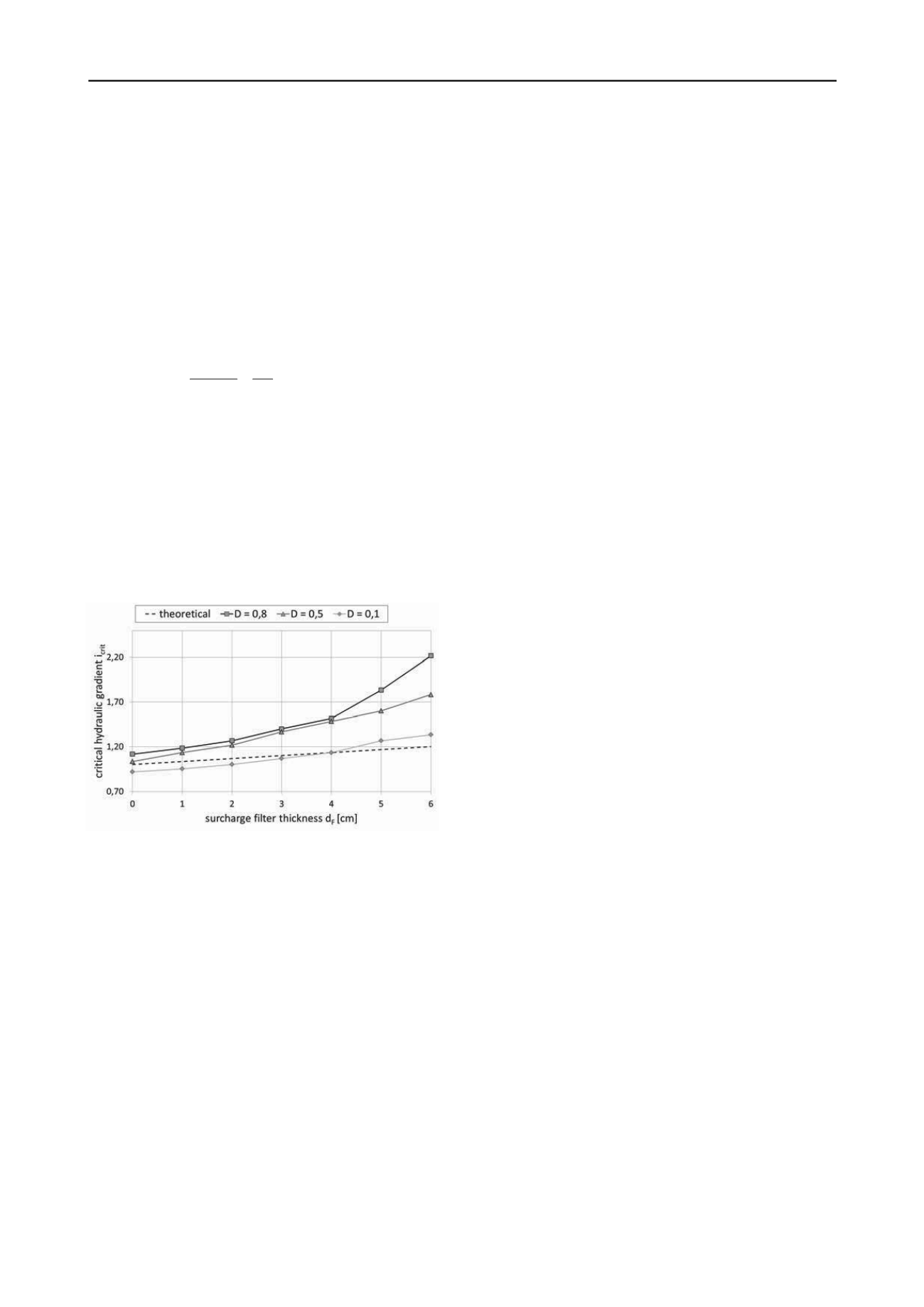
418
Proceedings of the 18
th
International Conference on Soil Mechanics and Geotechnical Engineering, Paris 2013
Proceedings of the 18
th
International Conference on Soil Mechanics and Geotechnical Engineering, Paris 2013
densities of the sand were combined with different sizes of the
surcharge filter d
F
.
5 TEST RESULTS
The critical hydraulic gradient i
crit
was determined in each test,
so that the dependence of the critical hydraulic gradient i
crit
on
the relative density D and the thickness of the surcharge filter
d
F
. could be shown.
Figure 7 shows the critical hydraulic gradient i
crit
as function
of the surcharge filter thickness d
F
for the different relative
densities D. Moreover, the figure shows the theoretical critical
hydraulic gradient i
crit,theoretical
calculated according Formula (1)
(l: length of the sand column). The figures also display the
difference between the test results and the theoretical approach.
W
S
W
F F
l
theoretica
crit
l
d
i
'
'
,
(1)
The results of the test series show that the critical hydraulic
gradient i
crit
strongly depends on the thickness of the surcharge
filter d
F
. With increasing thickness of the surcharge filter d
F
, the
critical hydraulic gradient i
crit
increases inverse proportionately.
The relative density D of the sand has a significant
influence on the critical hydraulic gradient i
crit
too. For a sand
with a low relative density (D = 0.1), the critical hydraulic
gradient i
crit
is smaller than theoretically calculated (Figure 7).
The results of the test series with a relative density of D = 0.5
and 0.8 show, that the critical hydraulic difference
h
crit
and the
critical hydraulic gradient i
crit
respectively is always higher than
the gradient theoretically predicted (Figure 7).
Figure 7. Critical hydraulic gradients of uniaxial flow-test
The disproportional increase of the critical potential
difference
h
crit
with increasing thickness of the surcharge filter
d
F
which was detected by the big-scale experiments could be
confirmed by the uniaxial flow-tests. The reasons for this
behavior will be analyzed in more detail by the Discrete
Element Method (DEM) by the Institute of Soil Mechanics and
Foundation Engineering of the Bundeswehr Universität
München.
The influence of the relative density D on hydraulic heave
safety, if a surcharge filter is installed on the pit bottom, needs
further investigation by experimental tests. Nevertheless, by the
analysis of the uniaxial flow-tests it becomes apparent, that the
relative density D of the basic material has a significant
influence on the hydraulic heave safety even if a surcharge filter
is installed on the pit bottom.
6 CONCLUSIONS
The experiments carried out at the Institute of Soil Mechanics
and Foundation Engineering of the Bundeswehr Universität
München strives for the verification of the approach with an
extended unstable block (Odenwald and Herten 2008). The
results of the big scale experiments fit quantitatively to the
results of the theoretical analysis. Thus, it could be observed
that there is an unfavorable embedment depth for a pit wall with
a surcharge filter on bottom of the construction pit floor. The
safety towards hydraulic heave increases when the embedment
depth is reduced or enhanced. According to that, the safety
towards hydraulic heave can rise due to reducing the
embedment depth. The numeric results are however more
conservative than the experimental results. This could be due to
the simplified failure shape as well as the neglected friction
forces in the sand and surcharge filter. Moreover, the difference
between the results of the experimental series and the
theoretical approach increases proportionally with increasing
thickness of the surcharge filter
Furthermore, one dimensional flow-tests were carried out to
determine the influence of filter thickness and relative density
of the test sand on the critical hydraulic gradient. The
experiments showed an inverse proportional correlation
between the critical hydraulic gradient and the thickness of the
surcharge filter. This was confirmed by the uniaxial flow-tests.
The object of further studies will be to verify and improve
the theoretical approach by means of the experimental results
towards the hydraulic surcharge and one dimensional flow-tests.
The improved approach has to consider friction forces and a
more realistic unstable block so that results get closer to reality
and the disproportional increase of critical potential difference
h
crit
with increasing filter thickness will be considered.
7 ACKNOWLEDGEMENTS
The project is supported by the Federal Waterways Engineering
and Research Institute Karlsruhe, Germany.
8 REFERENCES
Davidenkoff, R. (1970): Unterläufigkeit von Stauwerken. Werner
Verlag.
Odenwald, B., Herten, M. (2008): Hydraulischer Grundbruch: neue
Erkenntnisse. Bautechnik, Vol. 85, Heft 9, S. 585 – 595.
Schober, P., Boley, C., Odenwald, B., (2011): Hydraulic Heave Safety
at Excavations with Surcharge Filters. 3
rd
International Symposium
on Geotechnical Safty and Risk (ISGSR). 02. - 03. Juni 2011,
Munich, Germany, S. 677 – 684.
Schober, P., Odenwald, B. (2012): Der Einfluss eines Auflastfilters auf
die Bruchmechanik beim hydraulischen Grundbruch.
BAWMitteilungen Nr. 95 „Johann-Ohde-Kolloquium“, Karlsruhe,
S. 151 – 162.
Schober, P., Boley, C. (2012): Fracture behavior of uniaxial flowed
sand column with surcharge filter. 2nd IAHR, 27. - 29.06.2012,
Munich, Germany.
Terzaghi, K., Peck, R. B. (1948): Soil Mechanics in Engineering
Practice, John Wiley and Sons, New York.


